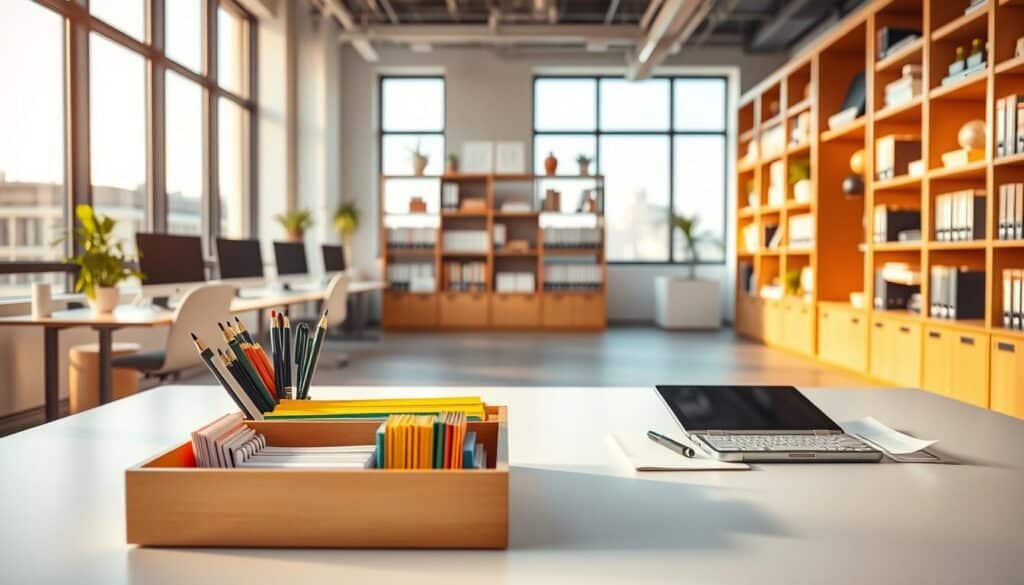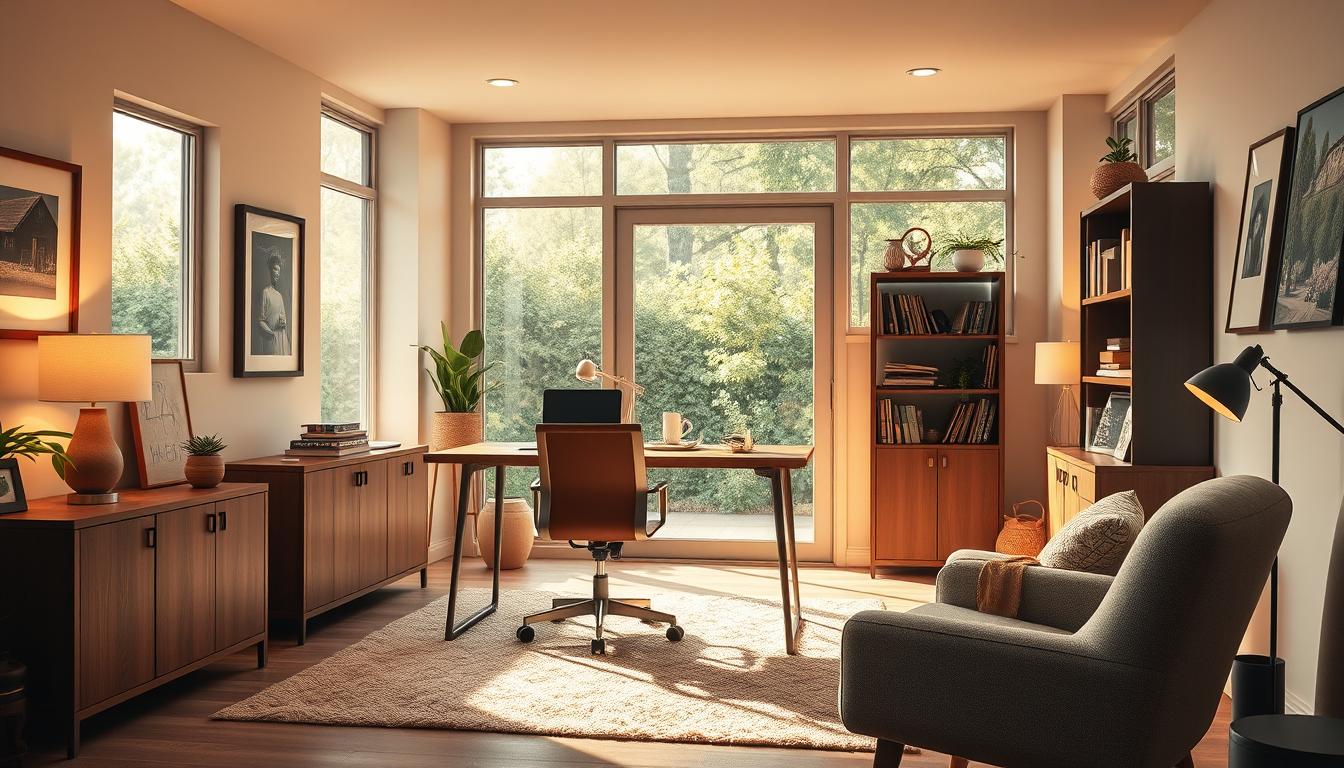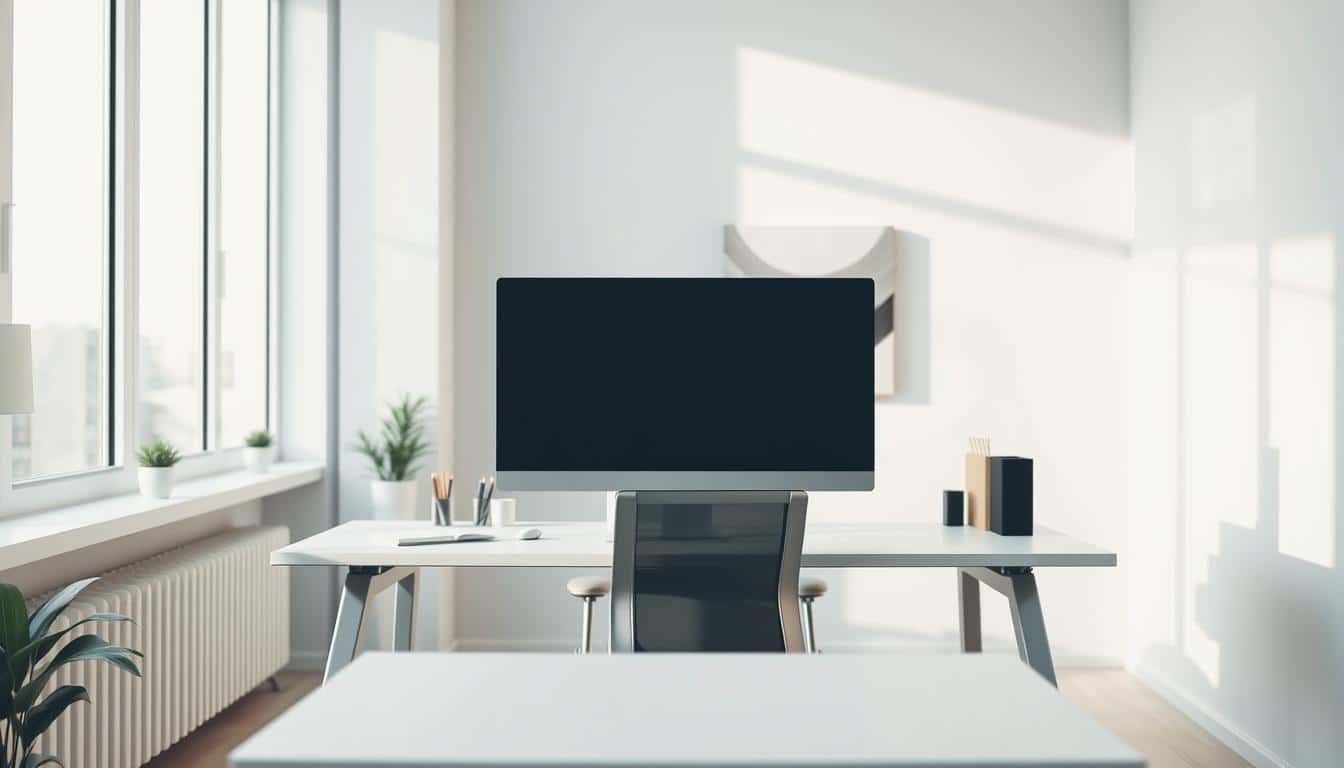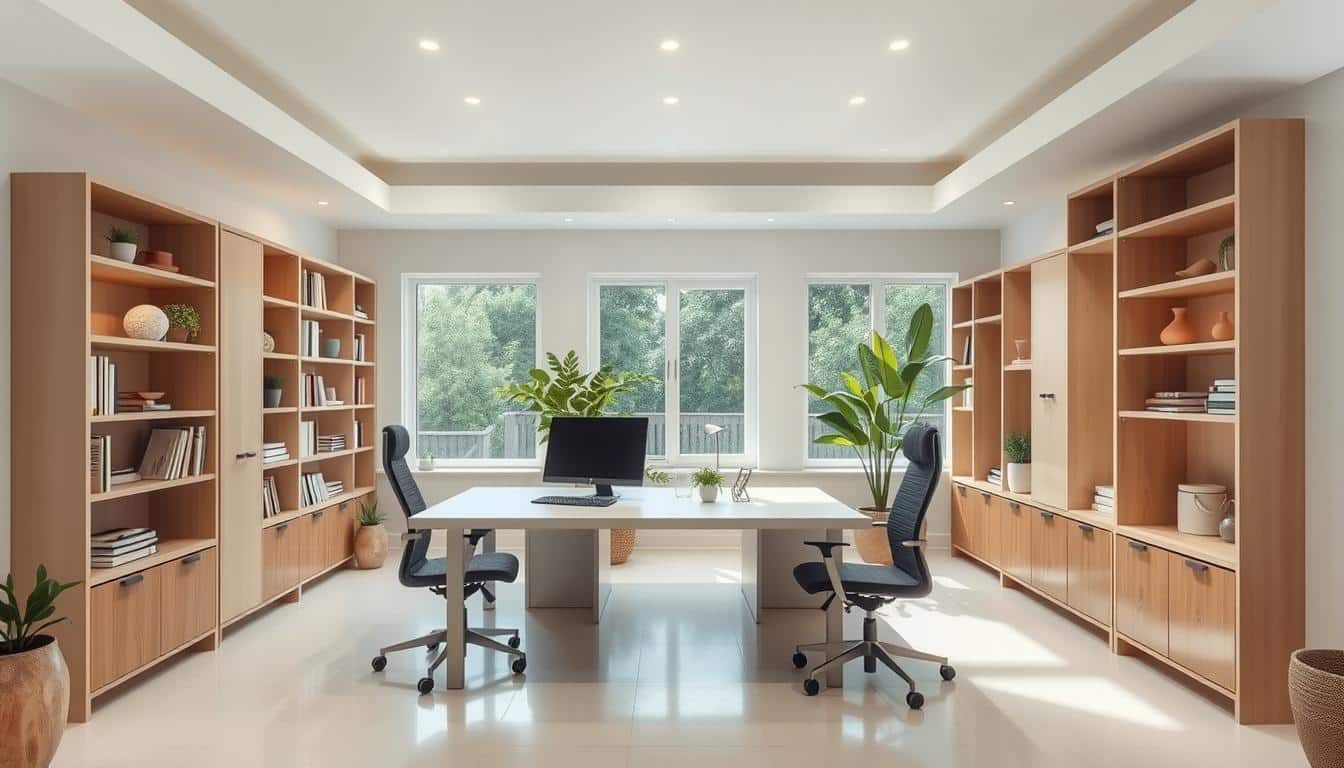In today’s fast-paced work environment, staying organized is key to being productive. A tidy workspace boosts efficiency and creates a positive vibe. We’ll share tips on how to declutter your office and make it more efficient. By keeping things organized, you’ll learn how to make your space work better for you.
Understanding the Importance of Office Organization
An organized office boosts productivity and focus. A cluttered office causes overwhelm and lowers efficiency. Keeping a clean desk helps work flow better and boosts morale.
Good organization saves time spent looking for things and cuts stress. A tidy office gives a sense of control and motivates everyone. Organizing well makes work more productive and the office nicer to be in.

Identifying the Role of Your Office Space
The purpose of office space changes a lot depending on the situation. It might be a solo spot for freelancers or a place where teams come together. Knowing what your office is for is key. It helps you set it up in the best way possible.
To start, think about these important questions:
- What specific tasks will be performed in this space?
- How can the office layout be structured to facilitate these activities?
- What types of furniture and organizational tools are necessary to support the intended function?
Finding out the role of your space has many benefits. It makes tidying up easier and organizes your efforts better. Making the layout match what you do there can boost how much you get done. It also makes the space work better for its users. This plan leads to a space that meets everyone’s needs well.
Steps to Declutter Your Office Effectively
Starting to declutter your office needs a plan. First, think about how you want your office to look and work. By doing this, you prepare for steps that will change how your work area looks.
Creating a Vision for Your Ideal Workspace
Imagining your perfect workspace is key in the decluttering process. Write down what would make it better for work and comfort. Think about having more space, how to arrange furniture, and decorations that make you want to work. This plan will guide you as you organize.
Removing Unnecessary Items
After you know what you want, get rid of things that don’t fit your vision. Look at furniture, old machines, and lots of papers that fill up your space. Say goodbye to anything that doesn’t match what you imagined, making your office nicer.
Categorizing Items for Better Management
With the clutter gone, organize what’s left. Group things as ‘keep,’ ‘donate,’ or ‘recycle.’ This makes organizing easier. Also, separate office supplies, gadgets, and personal things. This method keeps your office tidy and sticks to your initial plan.
How to Clear Your Desk for Productivity
A clean desk is key to better organization and more productivity. Start by clearing away items you don’t need. Keep only your computer, notepad, and essential supplies. This simple step helps you focus better.
Make it a rule to clean your desk at the end of every day. This keeps your space ready and welcoming. Studies have found that a tidy desk helps you focus and work better. Regularly check your desk and keep only what’s necessary.
Organizing Office Supplies Efficiently
Getting your office supplies in order boosts productivity. It starts with managing what you have smartly. First, take a close look at your current supplies. Aim to keep only the essentials that you often use. This is the first step toward smart inventory management.
Downsizing Office Supplies
Check your office supplies and get rid of outdated or seldom-used items. Keeping only the best and most used supplies makes your workspace better. Here’s how to cut down:
- Identify duplicates and unnecessary items.
- Introduce a “one in, one out” policy for future supplies.
- Donate or recycle items that are no longer relevant.
Designating Storage Areas
Having specific spots for your supplies keeps things organized. Use bins, drawers, or shelves for different supply types. This strategy fights clutter and makes finding what you need easier. Sort office supplies like this:
- Stationery (pens, pencils, paper)
- Technology (cables, chargers, devices)
- Miscellaneous (sticky notes, tape, staples)
Using Labeling for Quick Access
Labels on storage spots help you find things fast. This cuts down the time you spend looking for items, which is key for a smooth workflow. Make sure each storage area is labeled with what’s inside. Using high-quality labels makes keeping track of office supplies easy.
Paper Management Strategies for Office Organization
Keeping your office free from clutter is crucial. You can do this by having a good filing system and using digital options. These steps help businesses run smoother and boost their productivity.
Setting Up a Paper Filing System
To organize your papers well, you need a solid filing system. Think about these categories:
- Bills
- Forms to retain
- Items for shredding
- Recycling
This method not only cuts down on clutter. It also makes it easy to find documents when you need them.
Digital Alternatives to Paper Clutter
Going digital is a smart way to lessen paper use in your office. Tools like Google Drive or Dropbox keep your documents safe and easy to reach. Moving to digital files saves space and guards your important info. This shift is key for keeping your office neat.
Reorganizing the Physical Layout of Your Office
Creating an effective office layout boosts productivity significantly. By planning the space well, companies can encourage smart setup of workstations and good team interactions. Knowing what layout works best means the space can be customized for working together or doing solo tasks.
Creating Efficient Workstations
Setting up workstations right means more productivity and comfort. Consider these tips for better workstation setup:
- Design desks to accommodate necessary technology and supplies.
- Include collaborative areas that encourage teamwork.
- Utilize ergonomic furniture to support health and focus.
Considering Layout Impacts on Productivity
An office’s layout changes how work flows. Open spaces are great for teamwork but can be distracting. Finding the right balance is key. Here’s how to improve the layout:
- Encourage feedback from employees on their preferences for workspace layout.
- Ensure clear pathways for movement around the office.
- Incorporate quiet areas for focused work amidst collaborative spaces.
Implementing a Clean Desk Policy
A clean desk policy makes workspaces neat. It boosts workplace efficiency. Keeping desks tidy improves work habits and raises productivity. Sharing policy details helps everyone know how to keep their space organized.
To start a clean desk policy, try these steps:
- Create a list of what a clean desk should have. Include tossing out junk and keeping important tools handy.
- Reward those who follow the policy. This encourages everyone to keep their desks neat.
- Train employees regularly. Show them why a clean desk matters for efficiency.
Pushing for a clean work culture stops clutter. It also makes finding important stuff easier. A neat office looks more professional. This is good for both the team and clients.
Using Technology to Enhance Office Organization
Embracing office technology can make your workspace more organized. It adds productivity apps and visitor management systems, making the workplace smoother. Digital tools help get rid of mess and improve team chats.
Task Management Apps to Increase Efficiency
Task management apps are key for higher productivity. They let teams check on progress and deadlines. With these apps, tasks get assigned, reminders are set, and projects are plotted, keeping everyone on track. Popular ones include Trello, Asana, and Monday.com, fitting different work styles.
Visitor Management Tools for Better Workflow
Visitor management systems make your office more orderly and safe. They offer fast guest check-ins, avoiding the mess of paper logs. With systems like Envoy or Proxyclick, you can keep an eye on entries and exits, making your office secure yet inviting.
Maintaining Your Organized Office Space
Keeping your office organized is an ongoing task. It can boost productivity and make the area welcoming. Regularly clearing clutter helps stop your workspace from getting messy.
Regular Decluttering Habits
Use these decluttering tips to keep your office looking great:
- Check all items in your workspace every week.
- Take time each week to decide what’s really needed.
- Get rid of old documents and items you don’t use to keep things clear.
Creating a Monthly Organization Schedule
Setting up a monthly plan helps keep your office organized. Try these steps:
- Look over all items and processes often.
- Change your plan when your workload shifts.
- Pay extra attention to areas that get messy quickly.
Conclusion
Good office layout is key to boosting work and making a happy workplace. By following the tips we talked about, you and your company can really get better at keeping your space tidy. This helps everyone work better and more efficiently.
Our guide covered everything from how to clear out clutter to keeping your desk neat. Each point helps summarize how important a tidy workspace is. By following these steps, your work performance and happiness can see real gains.
Keep in mind, making your workspace tidy is a constant task. Staying committed to cleanliness brings ongoing rewards. It makes your work life easier and more rewarding. So, why wait? Start organizing your office now and see the positive changes.



